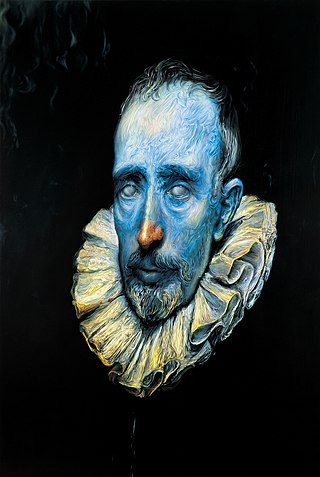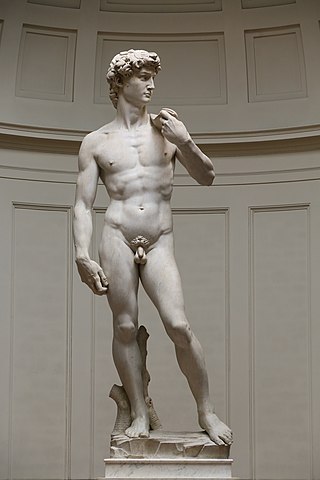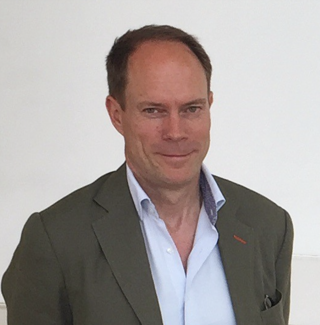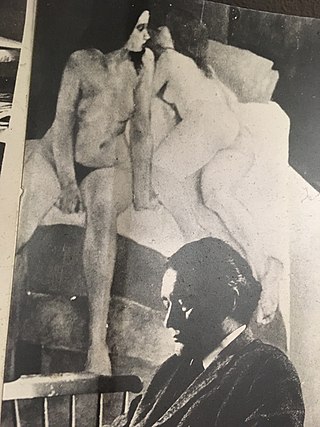
Frank Helmut Auerbach is a German-British painter. Born in Germany, he has been a naturalised British subject since 1947. He is considered one of the leading names in the School of London, with fellow artists Francis Bacon and Lucian Freud.

Lucian Michael Freud was a British painter and draughtsman, specialising in figurative art, and is known as one of the foremost 20th-century English portraitists. He was born in Berlin, the son of Jewish architect Ernst L. Freud and the grandson of Sigmund Freud. Freud got his first name "Lucian" from his mother in memory of the ancient writer Lucian of Samosata. His family moved to England in 1933, when he was 10 years old, to escape the rise of Nazism. He became a British naturalized citizen in 1939. From 1942 to 1943 he attended Goldsmiths' College, London. He served at sea with the British Merchant Navy during the Second World War.

Andrew Vicari was a Welsh painter working in France, who established a career painting portraits of prominent people. Despite being largely unknown in his own country, as of 2004 Vicari was Britain's richest living painter, and at one time Britain's 18th richest person.
Jennifer Anne Saville is a contemporary British painter and an original member of the Young British Artists. Saville works and lives in Oxford, England and she is known for her large-scale painted depictions of nude women. Saville has been credited with originating a new and challenging method of painting the female nude and reinventing figure painting for contemporary art. Some paintings are of small dimensions, while other are of much larger scale. Monumental subjects come from pathology textbooks that she has studied that informed her on injury to bruise, burns, and deformity. John Gray commented: "As I see it, Jenny Saville's work expresses a parallel project of reclaiming the body from personality. Saville worked with many models who under went cosmetic surgery to reshape a portion of their body. In doing that, she captures "marks of personality for the flesh" and together embraces how we can be the writers of our own lives."
Events from the year 2000 in art.

Glenn Brown is a British artist known for the use of appropriation in his paintings. Starting with reproductions from other artists' works, Glenn Brown transforms the appropriated image by changing its colour, position, orientation, height and width relationship, mood and/or size. Despite these changes, he has occasionally been accused of plagiarism.

Diana and Actaeon is a painting by the Italian Renaissance master Titian, finished in 1556–1559, and is considered amongst Titian's greatest works. It portrays the moment in which the hunter Actaeon bursts in where the goddess Diana and her nymphs are bathing. Diana is furious, and will turn Actaeon into a stag, who is then pursued and killed by his own hounds, a scene Titian later painted in his The Death of Actaeon.

The nude, as a form of visual art that focuses on the unclothed human figure, is an enduring tradition in Western art. It was a preoccupation of Ancient Greek art, and after a semi-dormant period in the Middle Ages returned to a central position with the Renaissance. Unclothed figures often also play a part in other types of art, such as history painting, including allegorical and religious art, portraiture, or the decorative arts. From prehistory to the earliest civilizations, nude female figures were generally understood to be symbols of fertility or well-being.

Bettina Shaw-Lawrence, also known as Betty Shaw-Lawrence, was an English figurative artist. Shaw studied painting and drawing under Fernand Léger, Cedric Morris and Arthur Lett-Haines, though she was mainly self-taught and worked professionally until the early 1980s.

Benefits Supervisor Sleeping is a 1995 oil on canvas painting by the British artist Lucian Freud depicting a fat, naked woman lying on a couch. It is a portrait of Sue Tilley, a Jobcentre supervisor, who then weighed about 127 kilograms (280 lb).
Peter Michael is an English contemporary figurative painter. Michael's work is firmly set in the British painting tradition of Lucian Freud and Jenny Saville, but references his classical Italian fresco training with hints of artists such as Mantegna.

Harry Blain is a British art dealer.
David Dawson is a British artist, born near Pwllheli, North Wales.
Celia Paul is an Indian-born British painter. Paul's mainly known for her impressionistic work, which she developed during her education at the Slade School of Fine Art.
Alex Kanevsky is a painter currently based in Tamworth, New Hampshire. His works combine abstraction and figuration in multilayered portraits that capture movement and the constant flow of time, resisting adherence to a single moment. Kanevsky's work is rooted in the artistic traditions of Eastern Europe, where he grew up, and the United States, where he now lives.
Martin Froy was a painter of figures, interiors and landscapes; part of a school of British abstract artists which flourished between the 1950s and 70s.
The School of London was a loose movement of 20th century painters, based principally in London, who were interested in figurative painting, in contrast to the abstraction, minimalism, and conceptualism which were dominant at the time. The London School of painters pursued an art focused on a kind of loose figurative form of post war Realism that reflected of the forms and people and the world around them. The term resonated regardless of the fact that there was no agreement of what this new figurative painting should look like, since the styles of painting of the group so markedly differed. Ranging from the violent brushwork presented by Bacon and Andrews, to the more explicit figuration of the celebrated Lucian Freud, and David Hockney. The common thread that held the London group together is less any form of explicit expression rather than their shared appreciation for the tradition and history of Figurative painting in a time dominated by Abstract painting. At the time this new wave of figurative painting was very controversial running against the dominance of abstraction, minimalism, and conceptualism violating the sacred hermetic codes that defined these forms of art.
Pilar Ordovas is an art gallery owner who founded her gallery in 2011. She exhibits and deals in 20th-century and contemporary art, presenting a programme of museum-quality shows in London and in New York.
The Brigadier is a 2004 oil on canvas painting by the British artist Lucian Freud (1922–2011). It is a larger than life seven foot high portrait of Andrew Parker Bowles. In 2015 the work sold at auction at Christie's in New York City for $34.89 million.

William Robinson Thomson RBA, ARCA was a British artist within the Modern British school of the late twentieth century. He is known for his portraiture and paintings of the female nude. Major influences on his work included Rembrandt, Degas and Cezanne.










